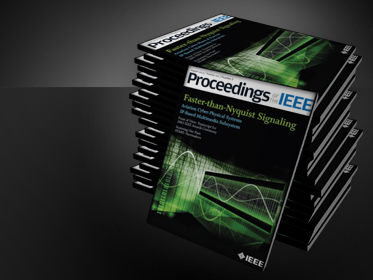On The Cover!
– Published 17 September 2013

Wireless communication is a runaway success with the public, but the number of bits that our systems need to carry is growing faster than traditional transmission methods can sustain. How can we carry more bits through a given space and radio spectrum? A number of ways are being explored at EIT, and one that was pioneered here is called faster than Nyquist (FTN) transmission. Three EIT researchers, John B Anderson, Fredrik Rusek and Viktor Öwall, have authored the paper “Faster than Nyquist Signaling”, a survey of FTN methods which was the cover article in the August 2013 Proceedings of the IEEE. The paper explains FTN signals, their receivers and the higher Shannon capacity. It also shows how FTN signals relate to standard methods in modern wireless networks, such as quadrature amplitude modulation and orthogonal frequency division multiplex.
Background
FTN methods pack 30% to 100% more data in the same bandwidth at the same energy per bit and error rate, compared to existing methods. This is its commercial attraction, but FTN also offers new ways to think about bandwidth, detection of bits and channel capacity. In particular, FTN addresses two great laws of data transmission, Nyquist’s limit to the speed of pulse transmission and Shannon’s capacity for the Gaussian data channel. The first FTN research was published by James Mazo of Bell Telephone Laboratories in the 1970s, after which the idea lay dormant for many years. It has awakened in recent years because of our networks need to carry more data and because we have the silicon technology to implement more complex signal processing.
Mazo’s work was controversial because it seemed at first glance to say that one could send data faster than Nyquist’s limit. More modern research has also led to controversy because it sometimes seems to say that one can exceed Shannon’s capacity. There is no need to worry: Both laws are still valid. The paradoxes disappear when ideas are more carefully defined. Nyquist’s limit applies to pulses that are orthogonal, which in simple language means that the pulses do not interfere with each other and can be detected separately. FTN lets the pulses interfere. The receiver becomes more complex but more data can be carried at the same error rate and in the same spectrum. Shannon’s capacity, as it is usually written, applies to signals with no spectral side lobes, that is, no energy outside a set, narrow bandwidth. Real signals have side lobes; this side lobe energy can carry a surprising number of bits, and the capacity that includes them is considerably higher.
A Few More Details
Most data transmission uses linear modulation in which a sequence of data pulses is add to form the final signal. In linear modulation, the pulses are almost always orthogonal , or “Nyquist”. Easy detection is possible with a matched filter and sampler. Currently, the most popular coding methods are based on orthogonal pulses. But there is a strong incentive in modern communication technology to make greater bit rates available to the customer, a need that can be satisfied in a number of ways. Four basic approaches are multiple-antenna techniques, improved networking, shorter radio wavelengths, and better signal design. Focusing on the last, we can ask, is there a way to carry more information per Hertz and second? This measure of efficiency is called data bit density. Transmission methods whose bit density is under 2 bits/Hz-s are called wideband (space communication is an example); those above 2 are called high energy because they achieve the same end by increasing symbol energy per channel (these are used in short range wireless communication). Most coding technology envisions wideband transmission. Increasing the bit density by increasing the symbol alphabet to octal or more is a common strategy; a consequence of this simple approach is a strong increase in the symbol energy. The FTN method can be viewed as a more sophisticated and efficient alternative.
As wireless systems offer higher and higher rates in the same radio spectrum, they need to work at a higher bit density. This requires more signal energy per bit. At the same time, whether by design or by necessity, networks are also becoming shorter range, which makes this energy available. Even space systems like satellite digital television face these demands, and fortunately have the bit energy available. FTN offers a method attuned to high energy systems, which can be coded or uncoded. It is thus an important solution to future wireless system demands.
The paper was in August among the top 100 most downloaded papers from IEEE Xplore, which is a data base providing access to more than 3-million full-text documents from some of the world's most highly cited publications in electrical engineering, computer science and electronics.
Text: John B. Anderson and Viktor Öwall
